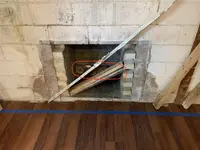I
idontno
New member
Hello Everyone,
Myself and a buddy of mine (who’s experienced in such work) are about to begin soundproofing a 300 square foot building that is in my backyard to use as a home recording studio. The building is just one rectangular room and we’re going to soundproof all four of its walls.
On the east wall, which is one of the shorter walls, there is an unused fireplace and chimney and the bottom of its back is currently exposed to the outside air. To see what I mean, if you look at the FireplaceCloseUp.jpg attached photo, what is circled in red are just stacked bricks separating the inside of the fireplace from the outside air.
I’d like to build a machine room as a closet inside the room and in front of the fireplace to keep noisy equipment. To see what I’m planning, take a look at the EastEndPlan.jpg attached photo. When I’ve googled or searched about machine room closets, I haven’t found any schematics and have only learned that cool air should come in, the hot air should go out, and that hot air rises. I literally don’t know anything else about them.
So my first set of questions are general ones about a machine room closet:
1) Does anyone have a schematic for building or designing one?
2) What materials should the closet be made out of?
3) Should it have both a cooling fan to bring air in and an exhaust fan to bring hot air out?
4) What are some recommended quietest and/or bang-for-your-buck fans to get?
5) Do people run the fans of their machine box or closet in such a setup while they record, i.e. is it possible to have super quiet fans?
6) What should the length, width, and height of the closet be? The ceiling of the building is 8 feet, 3 inches high, and the dimension from the wall to the closet door could be somewhat long, as it’s kind of dead space within the triangle that is formed between the monitors and the end of the desk.
The second part of my question is, should I utilize the fireplace and chimney somehow for the machine closet? Anyone have any ideas on how to utilize them for ventilation or anything? The chimney is maybe ~15 feet high and has a sealed cap on it.
If anyone has any questions or if I left anything out, please ask! I’m not the greatest handyman in the world, but I’m sure any ideas from you all will at the very least help my construction buddy come up with a design plan! Thanks so much in advance for anyone who can offer advice!!!
Myself and a buddy of mine (who’s experienced in such work) are about to begin soundproofing a 300 square foot building that is in my backyard to use as a home recording studio. The building is just one rectangular room and we’re going to soundproof all four of its walls.
On the east wall, which is one of the shorter walls, there is an unused fireplace and chimney and the bottom of its back is currently exposed to the outside air. To see what I mean, if you look at the FireplaceCloseUp.jpg attached photo, what is circled in red are just stacked bricks separating the inside of the fireplace from the outside air.
I’d like to build a machine room as a closet inside the room and in front of the fireplace to keep noisy equipment. To see what I’m planning, take a look at the EastEndPlan.jpg attached photo. When I’ve googled or searched about machine room closets, I haven’t found any schematics and have only learned that cool air should come in, the hot air should go out, and that hot air rises. I literally don’t know anything else about them.
So my first set of questions are general ones about a machine room closet:
1) Does anyone have a schematic for building or designing one?
2) What materials should the closet be made out of?
3) Should it have both a cooling fan to bring air in and an exhaust fan to bring hot air out?
4) What are some recommended quietest and/or bang-for-your-buck fans to get?
5) Do people run the fans of their machine box or closet in such a setup while they record, i.e. is it possible to have super quiet fans?
6) What should the length, width, and height of the closet be? The ceiling of the building is 8 feet, 3 inches high, and the dimension from the wall to the closet door could be somewhat long, as it’s kind of dead space within the triangle that is formed between the monitors and the end of the desk.
The second part of my question is, should I utilize the fireplace and chimney somehow for the machine closet? Anyone have any ideas on how to utilize them for ventilation or anything? The chimney is maybe ~15 feet high and has a sealed cap on it.
If anyone has any questions or if I left anything out, please ask! I’m not the greatest handyman in the world, but I’m sure any ideas from you all will at the very least help my construction buddy come up with a design plan! Thanks so much in advance for anyone who can offer advice!!!


